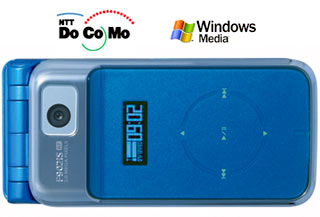DoCoMo's Blackberry: Q&A with Research in Motion Japan
 The pending Japan arrival of Research in Motion (RIM)’s hyperpopular BlackBerry email device, widely known as the ‘CrackBerry’ for its simple, efficient and addictive delivery of corporate email, will inject a new dimension into this country’s complex device and service matrix.
The pending Japan arrival of Research in Motion (RIM)’s hyperpopular BlackBerry email device, widely known as the ‘CrackBerry’ for its simple, efficient and addictive delivery of corporate email, will inject a new dimension into this country’s complex device and service matrix.
A wise move or a sign of desperation? These two viewpoints seem to characterize media, pundits’ and bloggers’ responses to last month’s announcement that DoCoMo would bring the BlackBerry email device into Japan, in partnership with RIM, based in Canada. Our own take on it was: Who Cares? WWJ was mindful that “virtually everyone in Japan’s workforce already has an always-on, fully connected email device right in their back pocket — in other words, a phone!”
Furthermore, before and since then, there has been more news, helping make it even more difficult to assess the BlackBerry’s prospects.
According to the pundits, NTT DoCoMo’s decision to import the BlackBerry is either (a) a master stroke aimed at securing the giant carrier’s corporate mobile offerings as 3G competition heats up in 2006/07, or (b) expensive folly that will see enterprise sales teams saddled with a clunky, ‘not-made-here’ device that competes poorly if at all against universal 3G phones that already receive push mail in real time, thank you very much (and some media reports have stated the first Japan BlackBerrys won’t even accept Japanese text input). The truth, however, is probably somewhere between these extremes, and so WWJ went straight to the source.


 DoCoMo today announced six summer 3G handsets, including ‘7-Series’ models from US maker Motorola, Sharp, NEC, Panasonic and Mitsubishi. The Japan-made models include three ‘designer’ phones, with ultracool shapes and colours conceived by noted Japanese design personalities, while Motorola joins the show with their M702iS and M702iG — the latter evidently based on the newest version of the widely popular ‘RAZR’ series, the Razr V3X.
DoCoMo today announced six summer 3G handsets, including ‘7-Series’ models from US maker Motorola, Sharp, NEC, Panasonic and Mitsubishi. The Japan-made models include three ‘designer’ phones, with ultracool shapes and colours conceived by noted Japanese design personalities, while Motorola joins the show with their M702iS and M702iG — the latter evidently based on the newest version of the widely popular ‘RAZR’ series, the Razr V3X. Last Thursday, NTT DoCoMo announced they would deploy the super-popular BlackBerry email device, made by Canadian firm Research in Motion (RIM), in Japan, in autumn 2006. At first glance, the news is pretty interesting.
Last Thursday, NTT DoCoMo announced they would deploy the super-popular BlackBerry email device, made by Canadian firm Research in Motion (RIM), in Japan, in autumn 2006. At first glance, the news is pretty interesting. As mobile music settles into a steady mainstream
As mobile music settles into a steady mainstream 
 In a rare quadruple play, DoCoMo today issued three new handset announcements plus one new technology tie-up press release. The first handset news includes the long-expected new credit-card-enabled phones that will come bundled with the carrier’s ‘DCMX’ Java-and-IC-chip-based credit card. The new
In a rare quadruple play, DoCoMo today issued three new handset announcements plus one new technology tie-up press release. The first handset news includes the long-expected new credit-card-enabled phones that will come bundled with the carrier’s ‘DCMX’ Java-and-IC-chip-based credit card. The new